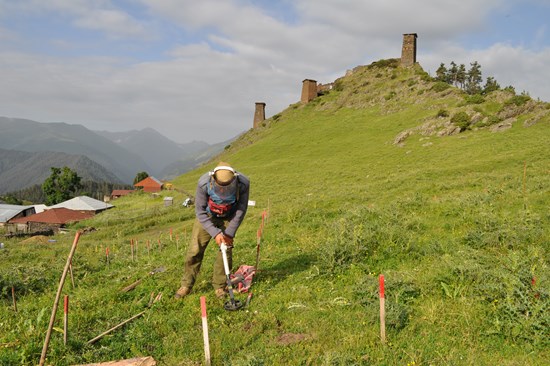Omalo and Shenako minefield, Tusheti Protected Area, Kakheti Region
The Omalo and Shenako minefield is situated in a national park in the Tusheti Protected Areas of Kakheti Region, close to the Chechen border of Russia. The historic 17th century Kesolo fortress is located in the area, and various medieval archaeological artifacts are scattered across the land. At the time of HALO's clearance in 2011, the area was used by villagers from Omalo and Shenako villages for grazing their livestock and increasingly being frequented by tourists. The historic site became a minefield in 1999 when OFM-1 Anti-Personnel mines were mistakenly dropped by Russian jets tarteting Chechen separatists across the border. A gorge separates Omalo and Shenako villages, and mines were dropped on both sides of the gorge. Since then, one accident involving a Georgian soldier took place on the minefield.
HALO received funding from PM/WRA in 2010 to clear the area. With support from the US Embassy in Tblisi, HALO negotiated with the Georgian Ministry of Defense (MoD) to obtain permission. HALO also drew on the support of the Georgian Ministry of Environment, the Agency for Protected Areas and the National Parks Office to seek their approval - and assistance - to work there. HALO received permission on 8th June 2011 and four clearance teams were deployed on July 1st.
After discussion with the National Parks Office, it became clear that the first priority for clearance was the site of the Keselo Fortress as it is a major attraction for visitors to the National Park. Following the clearance of the minefield around the fortress, HALO turned to clearing the large areas of pasture land close to Omalo village.
Clearance was completed on 20 November 2011 and 447,220m2 of minefield area was cleared. Eight items were found and destroyed; 4 of which were within 500 meters of historical structures. In addition to finding ERW, HALO teams also found 24 archaeological artifacts (such as arrowheads, spear tips and crucifixes) which were handed over to the National Parks office.
HALO deminers and team leaders were instructed to preserve all pieces of metal that were potentially historical; these artifacts were later handed over to the National Parks office for identification and preservation. Without this consideration, pieces of metal foundon minefields would have otherwise been collected in "contamination pits" and subsequently buried according to HALO's regular SOPs. Instruction also emphasized deminers not to keep any artifacts for personal gain, since they belonged to the entire country and people of Georgia.
After clearing the minefield, HALO not only ensure the safety of the 1000 villagers living in Omalo but also facilitated the development of tourism in the area. The site is now being visited safely by thousands of tourists every year and the rise in tourism has been a boon to the local economy.

HALO deminer conducting clearance near Keselo Fortress

Tourists can now walk safely on the ground close to the Fortress




 Visit our HALO USA website
Visit our HALO USA website
